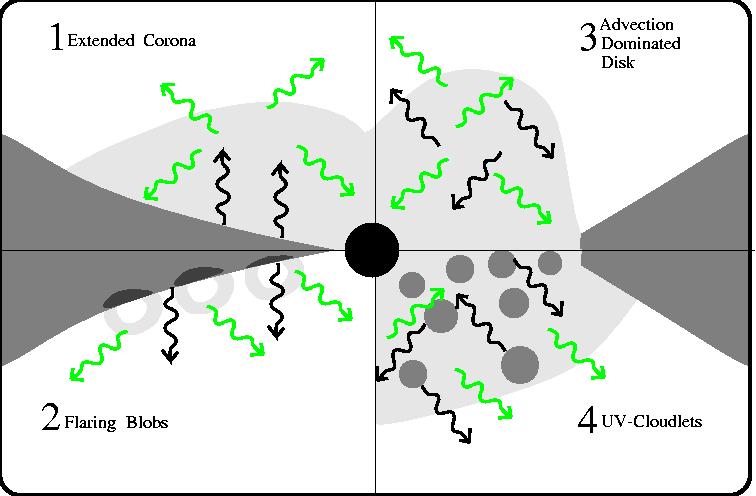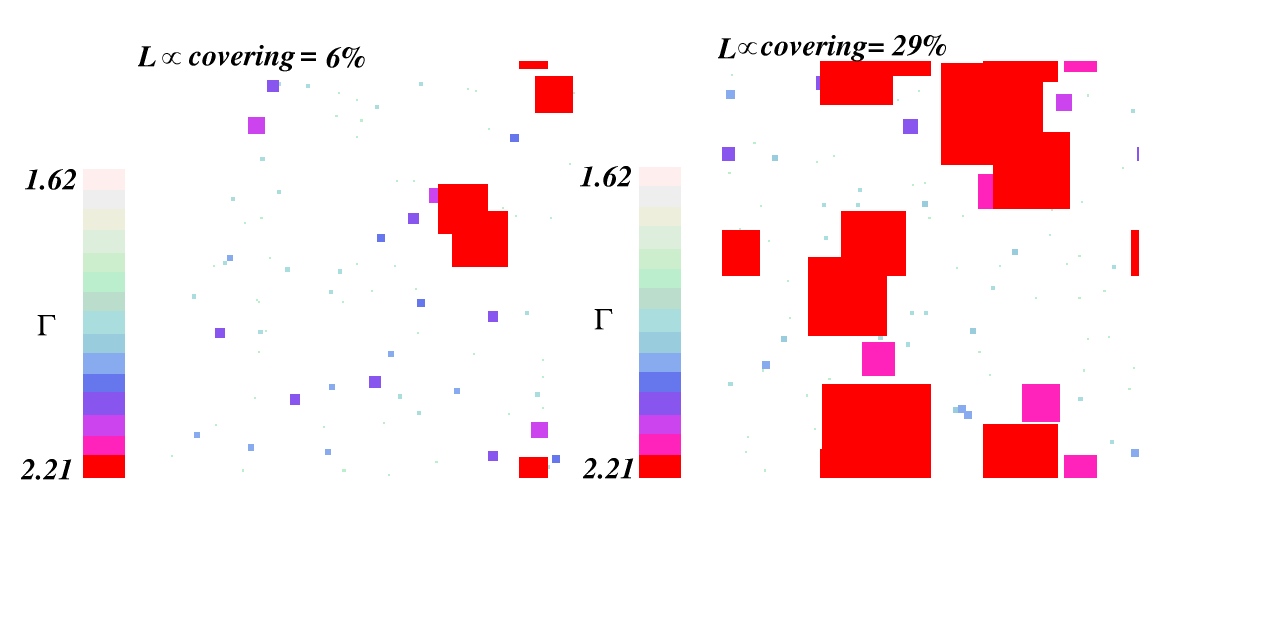Accretion disc coronae and magnetic flares
Introduction
The hard X-ray power law component in BHC and Seyfert galaxies spectra
is most likely due to multiple
Compton scattering (Comptonization)
of soft photons on a population of hot electrons which reside in a region
surrounding the accretion disc itself. In analogy with the sun, this hot,
optically thin Comptonizing region is often referred to as the accretion
disc corona.
X-ray spectral analysis alone is often unable to distinguish among
different possible geometries for the Comptonizing corona (Figure 1), and
more insight can be gained from multiwavelenght observations and detailed
models of all the relevant radiative processes involved.

Figure 1: The innermost region of the accretion
flow around a black hole according to four different models for the X-ray
emission. The relative scale of different components
is totally arbitrary. Black arrows indicate seed photons
for Comptonization (IR
to EUV depending on models), while green arrows indicate
inverse Compton emission
(X--rays). From Haardt
(1997).
It is now well established that magnetic stresses in accretion
discs are likely to be responsible for the transfer of angular momentum
(see
Balbus &
Hawley, 1998, Rev. Mod. Phys. 70, 1, for a review). Magneto-rotational
instabilities
can drive turbulence by amplifying the seed magnetic fields on roughly
Keplerian time scales; the rate at which magnetic energy is built up is
fast enough to explain the bulk of energy release in an accretion disk
as magnetic dissipation. This supports the idea that accretion disc
coronae are highly magnetic and form by buoyancy of the strong magnetic
fields amplified in the disk (Galeev,
Rosner & Vaiana 1979). This picture is supported by numerical
simulations which show that, when weak magnetic fields are amplified
via Magneto Hydrodynamic (MHD) turbulence in the disk, only a fraction
of the energy proportional to the aspect ratio of the disc is dissipated
locally while the rest escapes and forms a magnetized corona above the
disc. In the standard picture for viscously heated accretion discs, the
aspect ratio, i.e. the ratio of the height (H) to the radius (R) of the
disc is much lower than unity, so strong coronae are expected.
In any such models, the magnetic field in the corona is likely to be
strongly inhomogeneous and to dissipate energy in localized active regions
(Haardt,
Maraschi & Ghisellini 1994).
In the hot (T ~ 50 - 200 keV), highly magnetized, coronal plasma the
majority of the electrons are thought to be thermal and are expected to
produce Cyclo-Synchrotron emission, and Compton scatter the softer
photons
produced both by dissipation in the underlying accretion disk and by
the synchrotron processes themselves.
A Model for XTE J1118+480
We have recently applied a model for the emission from a highly magnetic,
structured corona to the optical and X-ray observations of the newly discovered
X-ray transient XTE J1118+480 (Merloni,
Di Matteo & Fabian 2000).
This source is unique for a number of reasons. It is located at high
galactic latitude and has a very high optical-to-X-ray flux ratio. The
source is observed in the typical black hole candidates hard state
(photon index Gamma ~1.8). Given the optical/UV to X-ray flux
ratio we have derived constraints for the approximate size, optical depth
and magnetic field strengths of the coronal active regions.
The main point of our work is that the simultaneous presence of a strong
quasi periodic feature in the optical and X-ray light curves clearly suggests
that the fluxes in the two bands both originate from the same
region in the inner part of the accretion flow. Self-absorbed cyclo-synchrotron
emission is the natural candidate to explain the optical variability.
Such emission is expected in any magnetic corona model, and the inferred
magnetic field value (B~2 ×10^6 Gauss)
is the one predicted to arise when the source is in the Hard state
(low value of the accretion rate and high value of the fraction of the
power dissipated in the corona).
Thunderclouds and accretion discs
X-ray observations of Seyfert 1 galaxies offer the unique
possibility of observing spectral variability on timescales comparable
to the dynamical time of the inner accretion flow. They typically show
highly variable lightcurves, on a wide range of timescales, with Power
Density Spectra characterized by `red noise' and a break at low frequencies.
On the other hand, time resolved spectral analysis
have established that spectral variability on the shortest
timescales is important in all these sources, with the spectra getting
softer at high fluxes (in the 2-10 keV band, typically).
We can use all these observational facts to test our understanding
of magnetic coronae, and in particular, on the nature of coronal heating.
In a recent paper
we showed that the sites of the fundamental heating events, likely caused
by magnetic reconnection,
must be compact, with typical size comparable to the
accretion disc thickness, but must be triggered at a height at least an
order of magnitude larger than that, in order for the dramatic spectral
variability to be explained. Also, in order to explain the observed time-variability
properties of such systems, spatial and temporal distribution of flares
should not be not random: the heating of the corona
proceed in correlated trains of events in an avalanche
fashion. Larger avalanches are brighter, but they also intercept more photons
from the underlying disc, and are therefore softer (see figure below).

The inner corona is mapped into a square. For simplicity,
the pixels have equal luminosity, and the total
luminosity scales with the covered area. The region of
the corona active at any time are represented by filled squares, whose
size is
distributed as a power-law, with index p=2. Each region
is assumed to have the same height above the disc and optical
depth. The color code shows the spectral index of the
filled active regions, calculated self-consistently taking into
account thermal Comptonization of disc photons and of
synchrotron emission in the active regions themselves. Clearly the more
luminous state (right hand side, for which the instantaneous covering fraction
is larger), is dominated by active regions with soft spectra.
The accretion disc corona therefore turns out to be
a highly inhomogeneous stochastic system, whose basic building blocks,
the active regions, can be viewed as `magnetic thunderclouds', charged
by the differential rotation of the underlying disc and/or the turbulent
motions in the accretion flow. The sizes of the thunderclouds are distributed
as a power-law. The fast energy release, triggered by magnetic reconnection
on the smallest scales, heats progressively larger active regions.
Each active region (thundercloud) produces the observed
rapid flares (X-ray lightning strokes) by inverse Compton scattering
soft photons coming mainly from the underlying optically thick accretion
disc. Furthermore, if the coronal optical depth is high enough, the
active regions may obscure the X-ray spectral features produced in the
cold disc for an observer situated above them (and act therefore
as `Compton clouds').
back to my
scientific homepage
These pages are maintained by Andrea Merloni;
last update: February 2002

